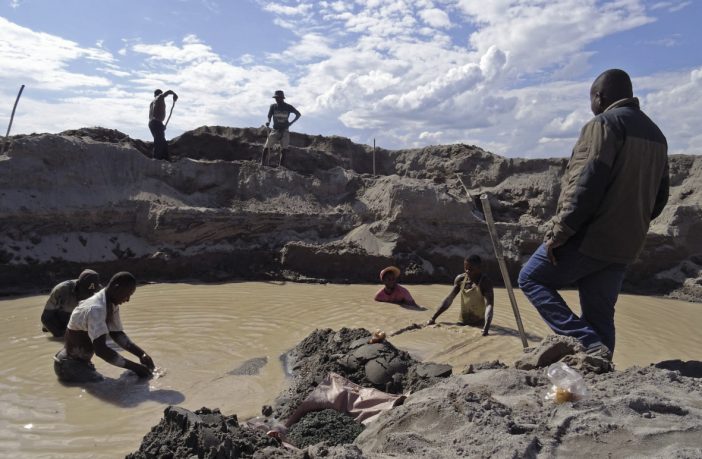- The country’s extractive reform strategy doesn’t address the impact of illegal cobalt mining on people, the environment and the economy.
The Democratic Republic of the Congo (DRC) is the world’s leading cobalt producer, contributing around 70% to global production. However, complex levels of organised crime occur along the supply chain of this strategic mineral from the DRC. These include illegal mining, smuggling and collusion between illegal miners, organised criminal gangs, and state-embedded actors involved in its extraction and trade.
Cobalt plays a crucial role in powering modern technology. It’s used to produce lithium-ion batteries, integral to electric vehicles, computers and smartphones. With the increasing shift towards renewable energy sources, there’s a massive demand for these batteries. Global demand for cobalt is projected to quadruple by 2030, primarily for electric vehicles.
The DRC has at least three ownership and operation levels for cobalt mining. In 2019, the government granted the Entreprise Générale du Cobalt the monopoly to acquire, process and market all artisanal cobalt produced in the country. It also established an authority to oversee and manage the production and export of minerals considered crucial to the DRC’s economic and national security. Lastly, multinational corporations launched emerging responsible cobalt sourcing programmes to mitigate supply chain risks by formalising artisanal cobalt production.
But the state lacks the capacity to monitor and enforce compliance, enabling local and foreign mining licensees to operate outside the rules of engagement.
Many foreign companies with mining licences don’t produce Congolese cobalt themselves, due to the country’s instability and volatility – instead sourcing it through artisanal miners. Around 150 000 to 200 000 artisanal miners work cobalt deposits in the DRC, and another million people depend on these miners’ incomes.
Cobalt smuggling is aided by corruption at DRC’s borders with Rwanda, Uganda, Burundi and Tanzania
The Mining Code stipulates that any adult citizen who wants to participate in the artisanal extraction of mineral resources must be a member of an authorised mining cooperative. To join such a cooperative, one must hold an artisanal mining permit – which is provided once miners have completed a formal registration process. Although they lack permits and are as such illegal miners, many don’t see their mining activities as unlawful and believe the minerals are rightfully theirs.
Artisanal cobalt miners tend to occupy mines in remote territories where it’s harder for the state to access and control. Those from surrounding communities sometimes buy protection (in cash or minerals) from the armed groups who control these isolated sites so they can extract the mineral. They sometimes sneak into the mines at night to work.
The amount of cobalt extracted from these inaccessible sites is largely unaccounted for and is impossible to trace. It’s funnelled into the licit global supply chain through corruption and smuggling.
Cobalt extracted from unauthorised sites is often brought to authorised sites for Congolese Ministry of Mines certification. This is enabled and regularly committed by official omission or collusion. Corruption, insufficient regulation and lack of government oversight make these practices along the supply chain from artisanal miners to multinationals hard to track.
The illegal exploitation of cobalt harms the local population and the environment
While soldiers and police aren’t allowed in mining areas (due to global certification requirements designed to prohibit blood or conflict minerals), the informality of mining operations in remote locations encourages their participation. Environmental advocates and civil society actors told the ISS that law enforcement officials visited sites at night to illegally obtain cobalt from artisanal miners, which they resold for profit.
Cobalt smuggling is aided by corruption at the borders with Rwanda, Uganda, Burundi and Tanzania, where poorly paid security officials are easily bribed. Border police reportedly know which vehicles smugglers use and turn a blind eye for a kickback. Soldiers and border law enforcement officers sometimes provide security for smugglers conveying cobalt to neighbouring countries.
Mineral smugglers devise ingenious means to remove cobalt from the DRC, sometimes presenting forged traceability and certification documents to border officials. Cobalt is also smuggled at night into neighbouring Rwanda via Lake Kivu, with its long frontier that’s difficult for marine patrols to monitor.
The illegal exploitation of cobalt harms the local population and the environment. Workers often don’t wear protective masks, and inhaling high levels can result in serious health issues, including cancer, respiratory diseases and heart problems. Paternal exposure to cobalt and mining by-products from occupational mining is the factor moststrongly associated with birth defects in the DRC’s mineral-rich communities. Cobalt mining also leads to toxic dumping that destroys landscapes, pollutes water and contaminates crops.
Policies are needed to address the challenges in the DRC’s mineral-rich regions
The country loses massive amounts of revenue through illegal cobalt production. In 2023, Finance Minister Nicolas Kazadi said the DRC lostalmost US$1 billion a year in minerals illegally smuggled into Rwanda alone. This bodes ill for the country’s economy and represents a missed opportunity to enrich the state treasury, alleviate poverty and enhance development outcomes.
Policies are needed to address the challenges identified in the DRC’s mineral-rich regions. These include reforming the regulation of the artisanal mining sector, bolstering security and law enforcement along the cobalt supply chain, and improving mineral traceability.
In 2021, the government indicated its desire to process raw materials domestically. It’s currently working with Zambia to create a specialised economic zone where raw materials can be transformed into preliminary products for the battery supply chain. Vuko Ndondo Kakule, the Congolese Battery Council’s Deputy Executive Director, said the DRC aimed to become one of the world’s leading battery producers by 2030 or 2040.
The state should match this aspiration with action by pursuing robust development and mining programmes for vulnerable populations in isolated communities where illegal cobalt extraction and trading are rife. This would help to create new jobs in the energy market and improve community members’ participation in the extractive sector by assuring the protection of their market share in the mining trade.
The government should address border corruption among security officials by simplifying and harmonising procedures, encouraging the use of new technologies, and focusing on organisational and institutional development by improving border officials’ welfare. Civil society could expedite the training of observer groups at the local level to monitor, document and submit incident reports on cobalt mining sites.
Author: Oluwole Ojewale
Oluwole is ENACT Central Africa Organised Crime Observatory Coordinator, ISS. This article was first published by ENACT and is republished with permission.














